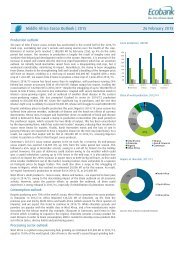www.ebook777.com
Make_Getting_Started_with_Processing_Second_Edition
Make_Getting_Started_with_Processing_Second_Edition
Create successful ePaper yourself
Turn your PDF publications into a flip-book with our unique Google optimized e-Paper software.
Example 4-5: Do the Same Thing Over<br />
and Over<br />
This example has the type of pattern that can be simplified with<br />
a for loop:<br />
size(480, 120);<br />
strokeWeight(8);<br />
line(20, 40, 80, 80);<br />
line(80, 40, 140, 80);<br />
line(140, 40, 200, 80);<br />
line(200, 40, 260, 80);<br />
line(260, 40, 320, 80);<br />
line(320, 40, 380, 80);<br />
line(380, 40, 440, 80);<br />
Example 4-6: Use a for Loop<br />
The same thing can be done with a for loop, and with less code:<br />
size(480, 120);<br />
strokeWeight(8);<br />
for (int i = 20; i < 400; i += 60) {<br />
line(i, 40, i + 60, 80);<br />
}<br />
The for loop is different in many ways from the code we’ve written<br />
so far. Notice the braces, the { and } characters. The code<br />
between the braces is called a block. This is the code that will be<br />
repeated on each iteration of the for loop.<br />
Inside the parentheses are three statements, separated by semicolons,<br />
that work together to control how many times the code<br />
inside the block is run. From left to right, these statements are<br />
referred to as the initialization (init), the test, and the update:<br />
Variables 41



